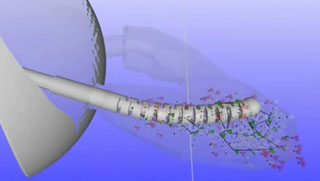Contact Us
CiiS Lab
Johns Hopkins University
112 Hackerman Hall
3400 N. Charles Street
Baltimore, MD 21218
Directions
Lab Director
Russell Taylor
127 Hackerman Hall
rht@jhu.edu
We have an active collaboration with the Johns Hopkins Applied Physics Laboratory to develop a robotic system for minimally-invasive curettage of osteolytic lesions in bone. One novel aspect of the system is a 6 mm diameter nitinol steerable “snake” end effector with a 4 mm lumen which may be used to deploy a variety of tools into the cavity. Although the initial focusing application is osteolysis associated with wear particles from orthopaedic implants, other potential applications include curettage of other osteolytic lesions such as bone metastases, intra-cardiac applications, and other high-dexterity MIS applications.
See the BIGSS page for additional details on this project.
 A robotic system has been developed to explore osteolytic
lesions in orthopedic surgery. Because of the difficulty of using
conventional surgical tools, such exploration is needed in minimally
invasive treatments of ``particle diseases,'' which commonly result
from material wear in total hip replacements. The path-planning framework we have developed assumes
no prior information about the geometry of the osteolytic cavity and
relies only on a model of the robot which is capable of collision
sensing. The framework relies on an effective combination of local and global
exploration strategies. Simulation experiments on surgically-relevant
osteolytic cavities demonstrate coverage rates of 82-93%.
A robotic system has been developed to explore osteolytic
lesions in orthopedic surgery. Because of the difficulty of using
conventional surgical tools, such exploration is needed in minimally
invasive treatments of ``particle diseases,'' which commonly result
from material wear in total hip replacements. The path-planning framework we have developed assumes
no prior information about the geometry of the osteolytic cavity and
relies only on a model of the robot which is capable of collision
sensing. The framework relies on an effective combination of local and global
exploration strategies. Simulation experiments on surgically-relevant
osteolytic cavities demonstrate coverage rates of 82-93%.